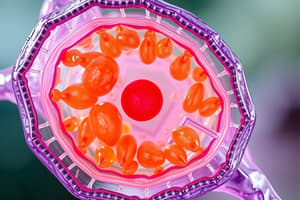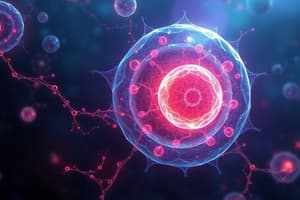Podcast
Questions and Answers
What is the function of ribosomes in a cell?
What is the function of ribosomes in a cell?
- Waste removal
- Genetic storage
- Energy production
- Protein synthesis (correct)
What did Robert Hooke observe in 1665 when he examined a thin slice of cork?
What did Robert Hooke observe in 1665 when he examined a thin slice of cork?
- Bacteria moving rapidly
- Plant roots growing
- Cells resembling honeycombs (correct)
- Animal cells dividing
Which type of cells lack a nucleus?
Which type of cells lack a nucleus?
- Animal cells
- Prokaryotic cells (correct)
- Plant cells
- Eukaryotic cells
According to cell theory, how do living cells reproduce?
According to cell theory, how do living cells reproduce?
Where is genetic material stored in a eukaryotic cell?
Where is genetic material stored in a eukaryotic cell?
Who observed cells in animals using a microscope?
Who observed cells in animals using a microscope?
What is the main function of the plasma membrane in a cell?
What is the main function of the plasma membrane in a cell?
What did Theodor Schwann and Matthias Jakob Schleiden propose about cells?
What did Theodor Schwann and Matthias Jakob Schleiden propose about cells?
Which organelle provides structure and support to the cell?
Which organelle provides structure and support to the cell?
What is the Latin meaning of the term 'cells' as mentioned by Robert Hooke?
What is the Latin meaning of the term 'cells' as mentioned by Robert Hooke?
How do cells communicate with each other?
How do cells communicate with each other?
Which British scientist made the first recorded observation of cells in 1665?
Which British scientist made the first recorded observation of cells in 1665?
Flashcards are hidden until you start studying
Study Notes
The Cell: The Building Block of Life
Cells are the fundamental units of life. Whether you are a bacterium, a plant, or an animal, all living organisms consist of one or more cells. Cells are the smallest unit capable of carrying out the processes of life, such as obtaining nutrients, converting them into energy, performing specialized functions, and reproducing.
Discovery of Cells
The first recorded observation of cells was made by the British scientist Robert Hooke in 1665. He used a microscope to examine a thin slice of cork and observed structures that resembled honeycombs. Hooke referred to these structures as "cells," deriving the term from the Latin word for "small room."
Cell Theory
Cell theory is one of the fundamental theories unifying all of biology. It states that:
- All organisms are made of one or more cells.
- All cells have many of the same structures and carry out the same basic life processes.
- Living cells arise only from other living cells.
These principles are supported by the observations of various scientists, including Robert Hooke, who discovered cells in plants, and Antonie van Leeuwenhoek, who observed cells in animals using a microscope. Other significant contributions came from Rudolf Virchow, who observed cells dividing and realized that they reproduce by cell division, and Theodor Schwann and Matthias Jakob Schleiden, who proposed that cells are the basic building blocks of all living things.
Structures of Cells
Cells have a common set of structures that are essential for their function. The plasma membrane, also known as the cell membrane, is the outer boundary of the cell. Cytoplasm, which is all the cellular material inside the plasma membrane, consists of a watery substance called cytosol. Ribosomes, where proteins are made, are found within the cytoplasm. Nucleic acids, such as deoxyribonucleic acid (DNA) or ribonucleic acid (RNA), carry the genetic instructions necessary for cell function.
Prokaryotic and Eukaryotic Cells
There are two main types of cells: prokaryotic and eukaryotic. Prokaryotic cells, found in organisms such as bacteria, lack a nucleus and other membrane-bounded compartments. Eukaryotic cells, found in organisms such as plants and animals, have a nucleus and other organelles, which are specialized structures that perform specific functions.
Cell Organization and Function
Cells are organized into organelles, which are membrane-bounded compartments that perform specific functions. The plasma membrane serves as the outer boundary of the cell, while the cytoskeleton provides structure and support. The cytoplasm is the fluid-filled space inside the cell, containing dissolved nutrients and waste products, as well as the cytoskeleton and various organelles.
Genetic material, stored in the nucleus or cytoplasm, carries the instructions for cell function. Prokaryotic genetic material is organized in a simple circular structure, while eukaryotic genetic material is more complex and organized in units called genes.
Cell Communication and Signaling
Cells communicate with each other through a variety of molecular signals, such as hormones and neurotransmitters. These signals are essential for coordinating cellular processes and maintaining the overall function of living organisms.
In conclusion, cells are the basic units of life, and understanding their structure and function is crucial for understanding how living organisms function at a molecular level.
Studying That Suits You
Use AI to generate personalized quizzes and flashcards to suit your learning preferences.




